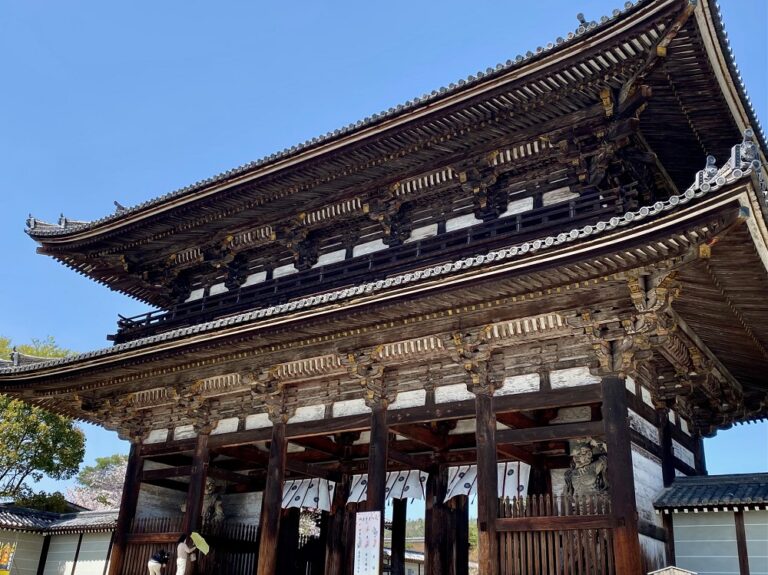Ninna-ji (仁和寺) temple is a Buddhist temple of the Shingon school. It is located in the Golden Pavilion district -Kinkakuji (金閣寺) and is part of “historic monuments of ancient Kyoto” listed as a Unesco World Heritage Site since 1994.

Ninna-ji History
Ninna-ji temple was founded in 888 by Emperor Uda (867-931). He became a monk at the end of his reign and retired to Ninna-ji temple. Since then, this temple was run by one of the members of the Imperial Family until 1869.
Most of the temple was lost during the Onin War in 1467. About 160 years later, in 1634, the reconstruction of the temple was finally authorized by the 3rd shogun of the Tokugawa family. Noteworthy buildings including the Kondo building and the Mie-do. These buildings were moved from the Imperial Palace and the reconstruction was completed in 1646.
Palace and Temple
As the function of the ‘grand monk’ was occupied by one of the members of the Imperial Family and he lived there, the temple was called Omuro Palace. Since the Meiji Restoration in 1868, the Imperial Family no longer lives there and it is now called Old Omuro Palace.
The temple area is considered to be divided into 2: the Goten old palace part (御殿) and the Garan (伽藍) temple part.
Goten (御殿): This was the residential part of the emperor in the temple. Here we can admire the well-worked gardens and the imposing halls.
Garan (伽藍): After passing through the vermilion gate, the middle gate -Nakamon (中門), we come to the temple part. On the right is the 5-story pagoda that was built in 1644. And at the back is the most important building for the temple, the Kondo (金堂) which houses the 3 most important statues of Ninna-ji Temple. The Kondo was moved from the Imperial Palace in the 17th century and this building, called Shishin-den (紫宸殿), was used for official ceremonies when it was still in the Palace. It is the oldest existing Shishin-den and has been classified as a national treasure as a building reflecting the palace architecture of the time.
The temple garden is famous for its cherry trees, Omuro-zakura (御室桜). It is one of the cherry blossom varieties besides Somei-Yoshino, the most common variety in Japan. Each flower is composed of 5 white petals and it is a little larger than Somei-Yoshino. The Omuro-zakura trees do not become very tall.
In autumn, we can admire the red maple leaves in the garden.
Access Information
Access: 3-minute walk from Omuro Ninna-ji station (Araden, Keifuku dentetsu)
Entrance (palace): 500 yen for high school students and above, 300 yen for middle school and high school students.
Entrance (garden): Charged only during cherry blossom season, 500 yen for adults, free for high school students and younger
Opening hours: 8.30 am – 5.30 pm. The opening hours change according to the season.
Your Japan Tour
As seasoned Japan experts, we create perfect Japan package tours including destinations like Kyoto. Check out our group tours and private tours, or contact us to start planning your unforgettable holiday to this fascinating country. Japan is full of once-in-a-lifetime experiences, culture, history, nature, and delicious food!